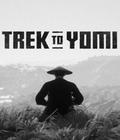Trek to Yomi puts you in the shoes of Hiroki, a young samurai apprentice. Our preview build follows him through two segments of his life. In the first, he's a young boy training with his master. An attack on the town forces him to take up the sword and defend his people, but this defense comes at the tragic cost of his master. The second level features an older Hiroki as he sets out to battle a warlord who has been razing villages and killing innocent people.
Trek to Yomi's combat takes place entirely on a 2D plane. Enemies may surround you in the foreground and background, but they generally come at you one at a time. Some may come from behind you or alternate attacks from the front and back with one of their allies. You're always facing a specific direction unless you tap a button or use a specific attack that turns you to face the opposing enemy.
The combat is straightforward. You have a heavy attack and a light attack and can string them together, as well as use directional buttons and attacks to perform a thrusting attack or a fast overhead attack. Stringing together combos is less important than just scoring a hit. A good chunk of your time is spent blocking and parrying, which uses the standard "block at the right moment to parry the enemy's attack" mechanic found in most games. A carefully timed parry opens up the enemy for a few attacks, but mistime it, and you can lose stamina or take a hit and lose some precious health.
Trek to Yomi adheres strongly to the samurai movie aesthetic, where death comes quickly. If you're playing well, you're going to buzzsaw through entire swarms of enemies with parries, counters, and the proper use of various attacks. However, if you mess up, you'll die quickly. Enemies can be aggressive, and attacks can take out multiple chunks of your life bar in a single go. Likewise, you can't block forever. Every blow or dodge drains some stamina. Lose all your stamina, and you go into a "tired" state where you're slower and only have access to a weak attack and parry. If you parry or hit the enemy in this state, you can replenish some stamina, but if you mistime it, you'll be in even worse shape than before.
The only way to replenish health is to reach a checkpoint, which refills your health and stamina, or use a "finisher" on an enemy. Finishers are performed on stunned enemies, but in the preview build, it didn't seem too easy to force enemies into a stunned state. Combat is so focused on short flashes of damage that most enemies die in one or two hits, long before a stun could occur. It felt less like a reliable mechanic and more like a fortunate bonus.
What makes Trek to Yomi distinctive isn't so much the combat but the aesthetic. The game is intentionally designed to mirror old samurai films, right down to being black and white and having a faintly "artificial" feel. This is most noticeable in the camera angles, which are designed to provide striking visual contrasts of light and shadows. It doesn't matter if you're fighting in silhouette or in the middle of a pitched rainstorm; it feels like a samurai film in ways that not even Ghost of Tsushima does.
Outside of combat, you can move in all three dimensions and explore the environment, but the areas we explored in our preview were pretty linear. There are ways to travel off the beaten path, which allows you to find hidden collectibles, including items that upgrade your health, stamina, unlock new moves, or give you special combat items such as a bo-shuriken. You head down a specific path, but the game rewards you for going off the beaten trail.
Trek to Yomi looks to accomplish exactly what it set out to do, which is to create a playable old-school samurai film. The core mechanics lend themselves well to that, and the visuals really shine. I found myself rather interested in each area I explored, just for the ways that they were shot and presented. All areas felt at least a little distinctive. Hopefully the final game can live up to the strong preview build when it comes out for PC, PlayStation 4, PlayStation 5, Xbox One and Xbox Series X|S later this year.
More articles about Trek to Yomi











 As a vow to his dying master, a young swordsman is sworn to protect his town and the people he loves against all threats.
As a vow to his dying master, a young swordsman is sworn to protect his town and the people he loves against all threats.






